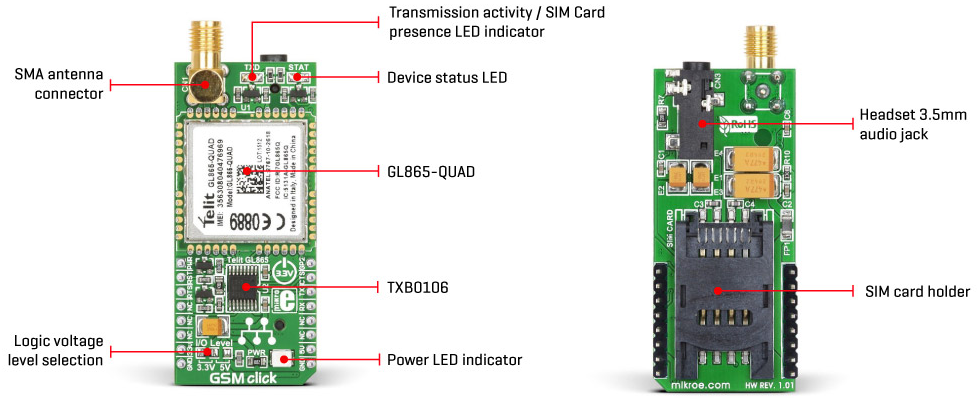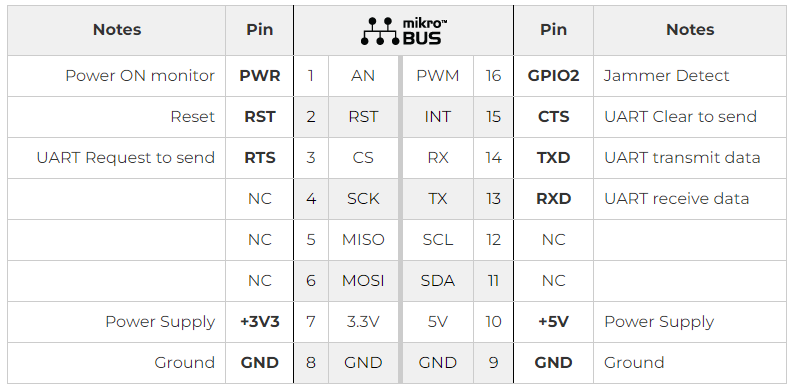Technical Specifications
Warranty Information
All the products supplied by Evelta are genuine and original. We offer 14 days replacement warranty in case of manufacturing defects. For more details, please visit our cancellation and returns page.
All the products supplied by Evelta are genuine and original. We offer 14 days replacement warranty in case of manufacturing defects. For more details, please visit our cancellation and returns page.
The MIKROE-1298 is a compact GSM/GPRS cellular network communication board based on Telit GL865-QUAD module. This module features a full set of options for the cellular networking and communication, such as the network status indication, jamming detection, embedded TCP/IP stack, including TCP, IP, UDP, SMTP, ICMP and FTP protocols, full GPRS class 10 implementation; GSM supplementary functions such as the call barring, waiting, forwarding, and holding, calling line identification presentation or restriction (CLIP/CLIR), integrated voice communication codecs, and more. This module also features an embedded Python Script interpreter, allowing users to run scripts from inside the module.
GSM click supports quad-band GSM/GPRS, allowing it to be used worldwide. A wide range of communication protocols and connectivity options, coupled with the embedded Phyton Script interpreter and Telit’s simple AT command interface via the UART bus, make this Click board™ a complete solution for a wide range of M2M applications, such as mobile Internet terminals, automatic meter reading (AMR), remote monitoring automation and control (RMAC), surveillance and security, road pricing, asset tracking, and similar applications which rely on a cellular network connection.

It covers frequencies of 850/900/1800/1900 MHz. The GL865-QUAD module is GSM/GPRS protocol stack 3GPP Release 4 compliant, and it is also compliant with eCall EU Directive. The GL865-QUAD module has to be powered by a clean and stable power supply. The voltage needed for the module to work properly is taken from the 3.3V mikroBUS rail and filtered by the filtering network, comprised of several capacitors and a ferrite bed.


MikroE provides a library for GSM click on our Libstock page, as well as a demo application (example), developed using MikroElektronika compilers and mikroSDK. The provided click library is mikroSDK standard compliant. The demo application can run on all the main MikroElektronika development boards.
FAQs:
Q: What communication technologies does the GSM Click support?
A: The GSM Click supports GSM/GPRS communication, enabling data transmission and voice calls over cellular networks.
Q: Which frequency bands does the Telit GL865-QUAD module support?
A: The module supports quad-band operation, covering GSM850, EGSM900, DCS1800, and PCS1900 frequencies for worldwide compatibility.
Q: What are the typical applications for the GSM Click?
A: Typical applications include remote monitoring and control, asset tracking, fleet management, security systems, vending machines, and other devices requiring cellular connectivity.
Q: What is the interface compatibility of the GSM Click?
A: The GSM Click is compatible with mikroBUS and communicates with the host microcontroller through a UART interface.
Q: What additional features does the GSM Click offer?
A: The GSM Click includes features like SIM card holder, SMA antenna connector, status LEDs, and a mikroBUS reset button for easy operation and integration into projects.